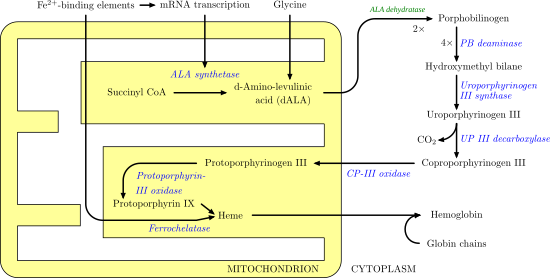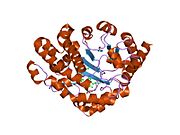Biology:Uroporphyrinogen III decarboxylase
 Generic protein structure example |
Uroporphyrinogen III decarboxylase (uroporphyrinogen decarboxylase, or UROD) is an enzyme (EC 4.1.1.37) that in humans is encoded by the UROD gene.[1]
Function
Uroporphyrinogen III decarboxylase is a homodimeric enzyme (PDB: 1URO) that catalyzes the fifth step in heme biosynthesis, which corresponds to the elimination of carboxyl groups from the four acetate side chains of uroporphyrinogen III to yield coproporphyrinogen III:
- uroporphyrinogen III [math]\displaystyle{ \rightleftharpoons }[/math] coproporphyrinogen III + 4 CO2
Clinical significance
Mutations and deficiency in this enzyme are known to cause familial porphyria cutanea tarda and hepatoerythropoietic porphyria.[1] At least 65 disease-causing mutations in this gene have been discovered.[2]
Mechanism
At low substrate concentrations, the reaction is believed to follow an ordered route, with the sequential removal of CO2 from the D, A, B, and C rings, whereas at higher substrate/enzyme levels a random route seems to be operative. The enzyme functions as a dimer in solution, and both the enzymes from human and tobacco have been crystallized and solved at good resolutions.
UroD is regarded as an unusual decarboxylase, since it performs decarboxylations without the intervention of any cofactors, unlike the vast majority of decarboxylases. Its mechanism has recently been proposed to proceed through substrate protonation by an arginine residue.[3] A 2008 report demonstrated that the uncatalyzed rate for UroD's reaction is 10−19 s−1, so at pH 10 the rate acceleration of UroD relative to the uncatalyzed rate, i.e. catalytic proficiency, is the largest for any enzyme known, 6 x 1024 M−1.[4]
References
- ↑ 1.0 1.1 "Entrez Gene: UROD uroporphyrinogen decarboxylase". https://www.ncbi.nlm.nih.gov/sites/entrez?Db=gene&Cmd=ShowDetailView&TermToSearch=7389.
- ↑ "Refinement of evolutionary medicine predictions based on clinical evidence for the manifestations of Mendelian diseases". Scientific Reports 9 (1): 18577. December 2019. doi:10.1038/s41598-019-54976-4. PMID 31819097. Bibcode: 2019NatSR...918577S.
- ↑ "Density-functional study of mechanisms for the cofactor-free decarboxylation performed by uroporphyrinogen III decarboxylase". J Phys Chem B 109 (38): 18195–200. 2005. doi:10.1021/jp051792s. PMID 16853337.
- ↑ "Uroporphyrinogen decarboxylation as a benchmark for the catalytic proficiency of enzymes". Proc. Natl. Acad. Sci. U.S.A. 105 (45): 17328–33. November 2008. doi:10.1073/pnas.0809838105. PMID 18988736. Bibcode: 2008PNAS..10517328L.
Further reading
- "Decreased activity of hepatic uroporphyrinogen decarboxylase in sporadic porphyria cutanea tarda.". N. Engl. J. Med. 299 (6): 274–8. 1978. doi:10.1056/NEJM197808102990603. PMID 661926.
- "Characterization of a new mutation (R292G) and a deletion at the human uroporphyrinogen decarboxylase locus in two patients with hepatoerythropoietic porphyria.". Hum. Genet. 89 (5): 548–52. 1992. doi:10.1007/bf00219182. PMID 1634232. http://repub.eur.nl/pub/58484.
- "Identification of a new mutation responsible for hepatoerythropoietic porphyria.". Eur. J. Clin. Invest. 21 (2): 225–9. 1991. doi:10.1111/j.1365-2362.1991.tb01814.x. PMID 1905636.
- "Uroporphyrinogen decarboxylase: a splice site mutation causes the deletion of exon 6 in multiple families with porphyria cutanea tarda.". J. Clin. Invest. 86 (5): 1416–22. 1990. doi:10.1172/JCI114856. PMID 2243121.
- "A point mutation in the coding region of uroporphyrinogen decarboxylase associated with familial porphyria cutanea tarda.". Blood 73 (4): 892–5. 1989. doi:10.1182/blood.V73.4.892.892. PMID 2920211.
- "Molecular cloning and nucleotide sequence of a complete human uroporphyrinogen decarboxylase cDNA.". J. Biol. Chem. 261 (21): 9825–31. 1986. doi:10.1016/S0021-9258(18)67589-1. PMID 3015909.
- "Assignment of human uroporphyrinogen decarboxylase (URO-D) to the p34 band of chromosome 1.". Hum. Genet. 73 (3): 277–9. 1986. doi:10.1007/BF00401245. PMID 3460962.
- "Structure of the gene for human uroporphyrinogen decarboxylase.". Nucleic Acids Res. 15 (18): 7343–56. 1987. doi:10.1093/nar/15.18.7343. PMID 3658695.
- "Uroporphyrinogen decarboxylase structural mutant (Gly281----Glu) in a case of porphyria.". Science 234 (4777): 732–4. 1986. doi:10.1126/science.3775362. PMID 3775362. Bibcode: 1986Sci...234..732D.
- "A mutation (G281E) of the human uroporphyrinogen decarboxylase gene causes both hepatoerythropoietic porphyria and overt familial porphyria cutanea tarda: biochemical and genetic studies on Spanish patients.". J. Invest. Dermatol. 104 (4): 500–2. 1995. doi:10.1111/1523-1747.ep12605953. PMID 7706766.
- "Oligo-capping: a simple method to replace the cap structure of eukaryotic mRNAs with oligoribonucleotides.". Gene 138 (1–2): 171–4. 1994. doi:10.1016/0378-1119(94)90802-8. PMID 8125298.
- "Molecular defects of uroporphyrinogen decarboxylase in a patient with mild hepatoerythropoietic porphyria". J. Invest. Dermatol. 102 (5): 681–5. 1994. doi:10.1111/1523-1747.ep12374134. PMID 8176248.
- "Uroporphyrinogen decarboxylase: complete human gene sequence and molecular study of three families with hepatoerythropoietic porphyria". Am. J. Hum. Genet. 58 (4): 712–21. 1996. PMID 8644733.
- "Five new mutations in the uroporphyrinogen decarboxylase gene identified in families with cutaneous porphyria". Blood 88 (9): 3589–600. 1996. doi:10.1182/blood.V88.9.3589.bloodjournal8893589. PMID 8896428.
- "Construction and characterization of a full length-enriched and a 5'-end-enriched cDNA library". Gene 200 (1–2): 149–56. 1997. doi:10.1016/S0378-1119(97)00411-3. PMID 9373149.
- "Crystal structure of human uroporphyrinogen decarboxylase". EMBO J. 17 (9): 2463–71. 1998. doi:10.1093/emboj/17.9.2463. PMID 9564029.
- "Familial porphyria cutanea tarda: characterization of seven novel uroporphyrinogen decarboxylase mutations and frequency of common hemochromatosis alleles". Am. J. Hum. Genet. 63 (5): 1363–75. 1998. doi:10.1086/302119. PMID 9792863.
- "A zebrafish model for hepatoerythropoietic porphyria". Nat. Genet. 20 (3): 239–43. 1998. doi:10.1038/3041. PMID 9806541.
- "Three new mutations in the uroporphyrinogen decarboxylase gene in familial porphyria cutanea tarda. Mutation in brief no. 237. Online". Hum. Mutat. 13 (5): 412–413. 1999. doi:10.1002/(SICI)1098-1004(1999)13:5<412::AID-HUMU13>3.0.CO;2-N. PMID 10338097.
- "Screening for mutations in the uroporphyrinogen decarboxylase gene using denaturing gradient gel electrophoresis. Identification and characterization of six novel mutations associated with familial PCT". Hum. Mutat. 14 (3): 222–32. 1999. doi:10.1002/(SICI)1098-1004(1999)14:3<222::AID-HUMU5>3.0.CO;2-V. PMID 10477430.
External links
- Overview of all the structural information available in the PDB for UniProt: P06132 (Uroporphyrinogen decarboxylase) at the PDBe-KB.

 |














